Showing posts with label 1960's. Show all posts
Showing posts with label 1960's. Show all posts
Wednesday, June 13, 2012
The Hustler (1961)
Obviously this is a classic, but to be honest, watching it the other day was really difficult. It just felt unnecessarily long, especially in the middle.
Monday, February 13, 2012
Ladybug, Ladybug (1963)

Frank Perry's "Ladybug, Ladybug" is definitely a movie of it's time. While many people frown on films that "date" themselves, I actually love movies for that exact reason. Often when I watch an older film in the theater, I spend a few moments thinking about what's going on outside the parameter of the frame. I think about things like what the film crew looked like and what else might of happened that same day. Movies are culturally significant in that they're reflective of art at the time they were made, as well as society, but each film is significant in it's own way because it captured moments in time from a day long forgotten. Even the worst movie has an interesting back-story; the act of making a film is itself often more interesting than the finally result. "Ladybug, "Ladybug" has been practically forgotten, but I couldn't help but think about what it must of been like to make this movie.

It's such a young, inexperienced cast, with such heavy material. It must of been quite the challenge. In short, the movie is about a small rural school that receives a signal indicating an atomic attack is going to happen within the hour. Not knowing whether it's real or just some sort of glitch, the Principle sends all of the kids home, escorted by their teachers.

In an effort to keep the children calm, the teachers are deliberately vague about why they are being sent home, but as time passes, more and more of them begin to suspect the worst. There's a real sense of beauty and dread to this movie. Part of it is due to the pacing of the film, it's slow and contemplative. There is also something idyllic about the scenery that adds to the ominousness.

The innocence of the children is "Ladybug, Ladybug's" biggest strength. Their fear, confusion, and inquisitiveness seems very real. There's a bit of a red herring about halfway through the film that I really appreciated in retrospect. It allowed me to be genuinely surprised by the direction it takes in the third act. The film is somewhat similar to "Miracle Mile," in the sense that it keeps you guessing up to the very end, which is always a nice device.

A few stray observations: I really like finale, even if seems a little on-the-nose by today's standards. It might "date" the film, but I can only imagine how haunting it must of been to see this in the theater in 1963. Also, the great William Daniels plays the Principal in the film. It's funny because he played a Social Worker/Child Protective Services Investigator in one of my favorite movies, "A Thousand Clowns," the voice of K.I.T.T. on "Knight Rider," and of course, he's probably best known for playing Mr. Feeny on "Boy Meets World. Somehow, he's always the voice of authority.
Wednesday, February 8, 2012
The Explosive Generation (1961)

This film was first brought to my attention when the AV Club's "Films That Time Forgot" featured it. The premise is about a small town that freaks-the-fuck-out when the high-school students begin discussing their true feelings regarding sex, in the classroom, against their parent's wishes. The main selling point for me was that the student's teacher is played by a young William Shatner.
There are a few interesting scenes in the third act, an early performance by Beau Bridges, and one or two chuckle-worthy moments in the film. Unfortunately though, I felt that the movie was a little too tame to be taken seriously and not quite goofy enough to have a good laugh at. In the end, I guess I just wanted more Shatner.
--Popkoff
Thursday, January 19, 2012
"The Haunting" (1963)

"The House...it's alive."
Julie Harris stars as Nell Lance, a troubled, sheltered woman, who takes the sudden invitation to take part in a paranormal "experiment" as an opportunity to escape from her family and her past. The experiment takes place in the supposedly haunted Hill House, and is essentially just a prolonged slumber party involving folks with a paranormal past or a vested interest in the house. The house itself is an incredible achievement in set design and one of the movie's most valued assets.

Harris' performance is very good, and her character's internal narration provides some of the film's most surreal and creepy moments. Her inner dialogue contributes to the film's atmosphere as much as the music, sound design, and cinematography, even in seemingly non-threatening scenes like this one early on of Nell anxiously driving to the house.

The movie opens with a tone-setting narration recounting the history of the Hill House and quickly establishes it's ominous powers. The opening narration plays like a collection of campfire ghost stories, detailing the house's long history of death. One of the most effective sequences in this portion is the aging transformation of life-time Hill House resident, Abagail Crane.


After receiving what he believes is an incredible opportunity, Dr. John Markway invites Nell, Theo (a psychic), and Luke(the house's new owner) to spend a few weeks at the Hill House to chronicle what they experience. After a few days of unexplained phenomenon, Nell's past comes out and she slowly begins to slip into madness. At which point, Dr. Markway's non-believing wife, Grace, arrives to take part in experiment, in spite of her husband's wishes.

The final act of the film is very taunt and it's a credit to the craftsmanship of it that nearly 50 years later, the film is still very suspenseful. The "haunting" sequences themselves have a somewhat hyperkinetic feel to them, yet are very focused in their execution. The final sequence is perfectly set in the darkness of the pathway leading up to the house. It reminded me of something that I think about whenever I'm driving in the middle of nowhere. I always think to myself that the only thing scarier than being alone in the darkness is seeing someone else.

--Popkoff
Wednesday, October 21, 2009
Succubus (1968) a.k.a. “Necronomicon"

Jess Franco’s hypnotic and dreamlike sex-trip came out in 1968, but was easily one of the craziest movies to play Fantastic Fest this year. Surreal and completely incoherent, yet ethereal and endlessly entertaining, it calls into question whether plot is even a necessity when every scene is interesting and unique. It was right up my alley.
This was one of four Jess Franco films that were shown in honor of him receiving the first ever Fantastic Fest Lifetime Achievement Award. Senor Franco was in attendance for 3 of the films, along with his wife and muse Lina Romay. I saw all four films and the Q & A’s that followed and I have to say that it was definitely an education. Though I enjoyed all the Franco films in the series (especially “Venus in Furs”), I wouldn’t include “Bare Breasted Countess” on my list of film favorites from the festival, but I do want to note that it provide me with perhaps the best moment of the festival, and definitely one of the most touching film experiences of my life. The film stars Romay and features a hefty amount of nudity and eroticism. It also features Franco in a strong supporting role as the Doctor who suspects that Romay is a murderous vampire. It was filmed when she was only 20 years old, and she admitted before the screening that she did not feel comfortable watching her films. She also noted, along with Franco, that it was this film that was the catalyst for them falling in love. As the movie began, Miss Romay left the auditorium, but Franco stayed for nearly 25-30 minutes, which was longer than he had stayed for any of the other screenings. As the film approached the end Lina helped Jess back into the theater for the Q & A. While the finale played out on screen I noticed the two of them staring up at the images together. Lina’s vampire was sprawled out naked in a bath of blood, while Franco’s doctor bursts through the door with intentions of killing her. It was the first time in the film that the Doc had seen the Countess, and his urge to kill is quickly snuffed out by her incredible beauty. So there it was, the two of them 40 years on, watching their younger selves fall in love on the screen. It was truly moving and it reminded me of what Lars, the host and organizer of the event stated at the beginning of the series. He read a quote by Franco that appeared in an Austin Chronicle interview the week of the festival: “The cinema is not the way to escape our lives; it is the way to complete our lives.”
--Popkoff
Thursday, November 13, 2008
Tarzana, the Wild Girl (1969)
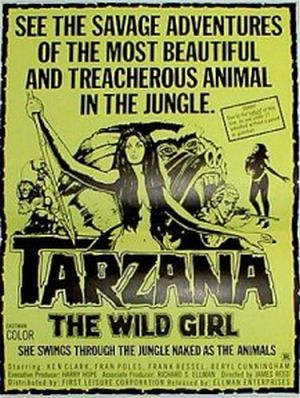
Rich Englishmen, Sir Donovan, had long believed his daughter had perished in a plane crash in Africa along with his wife and family, but when strange reports arrive over 15 years later of a local tribe crowning a white woman their queen (known as Tarzana), he sends a rescue expedition to Nairobi on the slim chance his daughter survived.
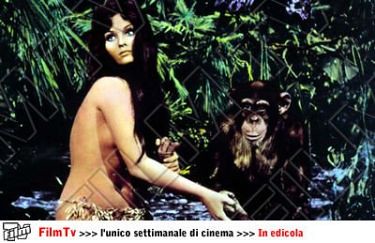
This Italian production finds Safari expect, Glen Shipper (resembling an older, taller Aaron Eckhart) accompanying Sir Donovan's representatives, Doris (Franca Polesello), and the sinister Groder (Franco Ressel, resembling a younger, thinner, Alan Rickman) in search of Tarzana.
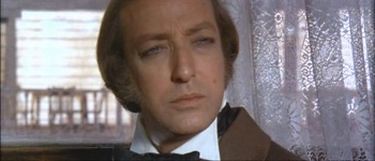
They bring along a team of helpers including the tribal dancer/trail-leader, Kamala, grizzled hunter, Lars, lecherous villain, Fred, and Shipper's driver who is a fat black man with a machete, who dresses exactly like Gilligan from “Gilligan's Island.” Along the way, the expedition wanders through a cave that looks strangely like the same one from “The Boogens.” They also find the 15 year old plane wreckage and they ward off stock footage of a lion that magically turns into a “dead” stuffed lion on a sound-stage.
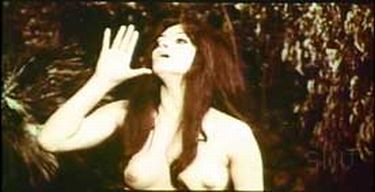
The real star of the film is Tarzana (Femi Benussi) herself, or more specifically, Tarzana's breasts. Much of the film consists of Tarzana walking around completely topless, wearing nothing but a jungle g-string, while posing on a sound-stage with an elephant, a baby lion (or was it a tiger?), and a particularly human-sounding monkey. Every once in a while she pauses to let out a bellowing toneless yell to summon various animals to her aide. To help give you an idea of how obsessed the movie is with Tarzana's breasts, in the climatic sequence at the end where Doris is appealing to Tarzana to come with her and Glen, she actually appeals to Tarzana's breasts by removing her own shirt and comparing her breasts to Tarzana's: "Look, we're the same.
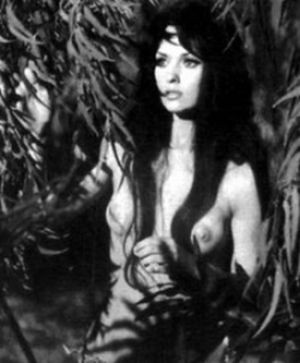
That's pretty much everything you need to know about "Tarzana, the Wild Girl," an unremarkable movie that was a sometimes boring, yet ultimately enjoyable Weird Wednesday.
Thursday, October 30, 2008
All the Sins of Sodom (1968)
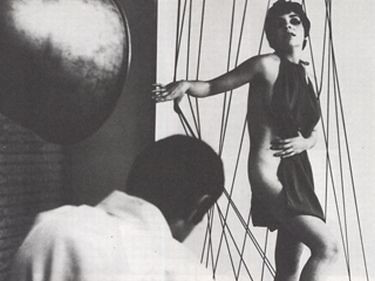
This was the second part of the Joe Sarno double feature, and it's a film that was thought to have been lost for 30 years. Apparently, the negatives were discovered recently and this digital transfer was made, and then screened to a sold out Weird Wednesday audience. There's something humbling about watching a film that hasn't been seen by anyone else in 30 years, or in some cases, ever. It was definitely more of what I'm used to from Sarno, exceptionally photographed Black & White sequences with iconic imagery, somewhat choppy editing, and performances that range from vibrant to cardboard.
The plot centers around a big city photographer looking to catch his big break in the world of model photography. Throughout the film he has a handful of muses, some innocent and coy, at least one of them is pure evil (well, sort of), but they all give themselves over to the photographer, both in front of the camera and behind it. When the photographer gets what he wants from both his innocent and evil muses, at what cost will he have to pay?
To be honest, I was completely conscience during this movie, but because of the slow pace and limited plot, it's hard for me to recall specific details that stood out to me. I remember thinking that the evil muse was not really my type, but that she was so wonderfully filmed that I understood why she was the catalyst in the movie. I also remember thinking that the male lead, the photographer, was not up to the challenge of acting against the female cast. His exclamations of frustration to his model; “No, no, it's not evil enough,” induced more laughter in the theater than understanding. I remember the goofy faces the elevator operator made in the background of his shots, which I think is funny now, since he's the only male in the movie that got a film credit on IMDB.
After the movie, I went out into the lobby and met Joe Sarno. I watched his trembling hand scribble out an inscription on my copy of “The Love Merchant.” The young man next to him asked Sarno if he remembered that picture, and he replied with fondness for it. I wonder what that night at the Alamo was like Sarno? I remember during the screening of “Abigail Lesley,” looking down the row of seats and seeing Joe's face as he watched the screen. I wonder what it was like to watch it in theater with an audience, after all these years?
The inscription on my dvd said: “Hey Popkoff! Enjoy the Sex! - Joe Sarno.”
Here's is a bit of one of the Q & A's from that night:
“All the Sins of Sodom” screened at midnight on 10/1/08 at the Alamo Ritz and was presented by Weird Wednesday.
Labels:
1960's,
Alamo Ritz,
Joe Sarno,
Movies,
Weird Wednesday
Sunday, August 10, 2008
Last Year at Marienbad (1961)
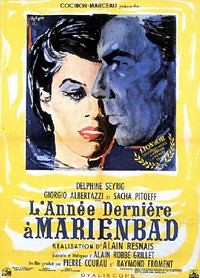
On the heels of watching Luis Buñuel's "The Discreet Charm of the Bourgeoisie" for the first time, I took in a Thursday night screening of Alain Resnais' "Last Year at Marienbad" at the Paramount. Though both films are considered to be relatively plotless, sureal, and dreamlike, "The Discreet Charm" was far more entertaining in the traditional sense, sacrificing emotional residence for whimsy and quirkiness. "Marienbad" on the hand was a slow-moving-train that was at times tedious and boring, but did also possess certain merits; a carefully nuanced tone, stark cinematography, & a haunting musical score, just to name a few.
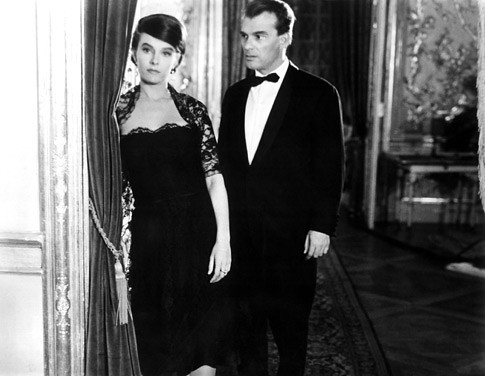
The plot, if you can call it that, revolves around a giant luxury hotel and the several guests who return there year after year. Two of these guests spend almost the entire film walking around the hotel debating their relationship to one another. The man is passionate about the woman and claims to have had an affair with her the previous year, but the woman denies any such affair ever occurred. Who is telling the truth? As the trailer puts it, "It's up to you, the audience, to decide." That's right, in true art-house form, the film ends with a completely open-ended non-resolution.
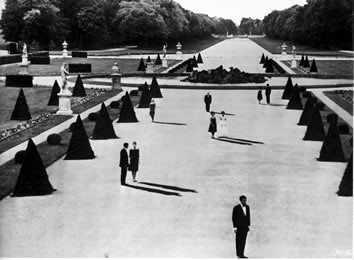
The film manages to have a genuine circular and dreamlike quality to it that is interesting, but at the same time irritating. The tone is due partly to the eerie coldness of the other guests, especially the card-playing husband character, but it is also due to the dialog of the film, which is not only repeated in narration, but is also respoken by characters throughout the film in different contexts. I can't say that I really liked "Last Year at Marienbad," but I can't say that I regret seeing it either. Perhaps I'll take in another viewing at some point down the line just to see what more I can take away from it.
"Last Year at Marienbad" screened on 8/7/08 at the Paramount.
Subscribe to:
Posts (Atom)

